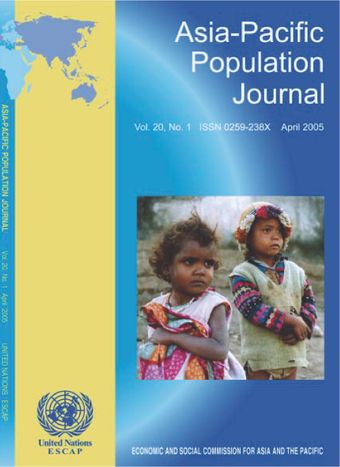Asia-Pacific Population Journal - Volume 20, Issue 1, 2005
Volume 20, Issue 1, 2005
Issued three times a year, the Asia-Pacific Population Journal is an invaluable resource containing opinions and analysis by experts on important issues related to population. It provides a medium for the international exchange of knowledge, experience, ideas, technical information and data on all aspects of population.
-
-
Why are population and development issues not given priority?
More Lessمؤلف: Gavin W. JonesFrom the time of Adam Smith onward, economists have recognized important linkages between population trends and economic development. Yet, the attention given to these linkages in international conferences and other venues where policy is debated has varied enormously over time, and also according to the issues being discussed: women, environment, poverty and sustainable development, for example. Looking back over recent decades, it is hard to escape two conclusions: (a) politics sometimes plays a more important role than dispassionate academic discourse at such meetings, and this greatly influences the attention given to population matters; and (b) fads are almost as ubiquitous in international thinking on development issues as they are in matters of dress, eating habits and youth culture.
-
-
-
Assessment of fertility behaviour change in the sociocultural context of Pakistan: Implications for the population programme
More Lessمؤلف: Naushin MahmoodThe process of change in fertility behaviour has been explained by social scientists in a variety of contexts. They give diverse interpretations of the reasons underlying these changes. A number of theories and arguments put forward on the subject contend that the level of socio-economic development on one hand and the quality of family planning services on the other are primarily responsible for reducing fertility levels in a society. The available literature however suggests that social values and cultural precepts play an important role in shaping the reproductive attitudes of couples and that this factor ultimately affects fertility outcomes. Hence, it is important that, in developing programme strategies, the local social and cultural context of the setting being studied be taken into account (Coale, 1973; Pollak and Watkins, 1993; Sultan, Cleland and Ali, 2002 and Stephenson and Hennink, 2004).
-
-
-
Does economic inequality matter in cases of infectious childhood diseases? An analysis for India
More Lessمؤلف: Saswata GhoshAlthough remarkable declines in infant and child mortality have been observed in developing countries during the last quarter of the twentieth century, the incidence and the prevalence of infectious diseases among children under five years of age still persist at an alarmingly high level, especially in sub-Saharan Africa and South Asian countries in the ESCAP region. Over two thirds of the estimated 3.7 million deaths of children in South Asia in the year 2000 were attributable to infections such as pneumonia (acute respiratory infections), diarrhoea and measles (UNICEF, 2004; Black, Morris and Bryce, 2003). In India, diarrhoea, acute respiratory infections, tuberculosis and chronic hepatitis continue to threaten the lives of millions of children.
-
-
-
Bangladeshi migrant workers in Singapore: The view from inside
More LessAuthors: Mizanur Rahman and Lian Kwen FeeSince the end of the Second World War, the international migration of labour has grown in volume and changed in character (Castles and Miller, 1998). It has also been observed that there are two main phases in post-Second World War migration (Castles and Miller, 1998, p.67). In the first phase, from 1945 to the early 1970s, large numbers of migrant workers were drawn from less developed countries into the fast-expanding industrial areas of Western Europe and North America. However, the organized recruitment of migrant workers by industrialized countries ended in the early 1970s owing mainly to the fundamental restructuring of the global economy and the politicization of migration (Castles, 2001). The second phase began in Asia in the mid-1970s. The phenomenal rise in oil prices since the end of 1973 generated a huge demand for temporary migrants in Middle Eastern countries. This massive demand for temporary migrants resulted in an enormous flow of labour to oil-rich Arab countries. In addition, since the mid-1980s the demand for temporary migrants grew in the prosperous countries of East and South-East Asia and a large number of migrants migrated to these countries for temporary employment. Bangladeshi migrants are found in both destinations.
-
-
-
Does retirement affect healthy ageing? A study of two groups of pensioners in Mumbai, India
More LessAuthors: Aparajita Chattopadhyay and T.K. RoyThe World Health Organization (WHO) defines health as a state of complete physical, mental and social well-being and not merely the absence of disease or infirmity. Among the many concerns of humankind, the ability to lead a life free from illness or disability during old age is a dominant one. Health is thus a key factor to livability. For older persons, health determines their ability to perform the tasks that facilitate their participation in society. Society for its part depends on the good health of its members to enable them to perform their roles adequately, be they of an economic, community or family nature.
-
Volumes & issues
-
Volume 32
-
Volume 31
-
Volume 30
-
Volume 28
-
Volume 26
-
Volume 29
-
Volume 27
-
Volume 25
-
Volume 24
-
Volume 23
-
Volume 22
-
Volume 21
-
Volume 20
-
Volume 19
-
Volume 18
-
Volume 17
-
Volume 16
-
Volume 15
-
Volume 14
-
Volume 13
-
Volume 12
-
Volume 11
-
Volume 10
-
Volume 9
-
Volume 8
-
Volume 7
-
Volume 6
-
Volume 5
-
Volume 4
-
Volume 3
-
Volume 2
-
Volume 1
Most Read This Month


